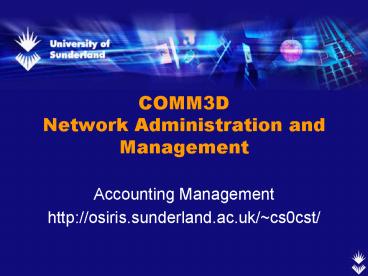COMM3D Network Administration and Management - PowerPoint PPT Presentation
1 / 15
Title:
COMM3D Network Administration and Management
Description:
Students should be able to identify the various tasks associated with ... Check throttle limits - Host status - Billing data. 3 Steps to performing accounting ... – PowerPoint PPT presentation
Number of Views:67
Avg rating:3.0/5.0
Title: COMM3D Network Administration and Management
1
COMM3DNetwork Administration and Management
- Accounting Management
- http//osiris.sunderland.ac.uk/cs0cst/
2
Objectives
In todays lecture Network Management 5 Core
Roles Introduction to Accounting Management
Implementing Accounting Management Learning
outcomes Students should understand the purpose
of performing accounting management. Students
should be able to identify the various tasks
associated with performing accounting
management. Knowledge of the various account
management systems.
3
The Network Manager (5 Key Roles)
Accounting Management involves tracking each
individual or group of users and the way they
utilise your network. Configuration Management
tracking the software and settings of each device
on use in your network. Security Management
controlling access to information and resources
on the network. Fault Management the process of
identifying and solving problems on your network
(pro-actively). Performance Management measuring
the performance of your network such that you can
identify problems before they occur.
4
Account Management - Intro
Definition Accounting management involves
measuring the usage of network resources by users
in order to establish metrics , check quotas ,
determine costs , and bill users. (Leinwand
and Conroy, 1996) Requires Authentication
Schemes Gathered statistics - logging Policies In
frastructure Analysis
5
Why do we do it ?
- Billing Who uses what resource and how much a
particular activity cost. - Starvation Ensure that no one user / group takes
a disproportionate amount of resources. - Resource management Some resources on the
network are contended so provision must be made
to monitor use. - Influence users User behaviour can be changed by
enforcing accounting policies - Trend Analysis Plan for the future do we need
more capacity?
6
3 Steps to performing accounting
Gather Information in order to manage users and
resource use across your network you must gather
statistics about their behaviour! Infrequent
(once / twice a day) - Check disk quota usage -
Produce bandwidth reports - Calculate usage by
group Frequent (perhaps every 5 seconds) -
Check throttle limits - Host status - Billing
data
7
3 Steps to performing accounting
Set Quotas Based on the principle of fair usage
it is important to manage the way in which your
users utilise contended resources. Example AUP
Acceptable Usage Policy. A large part of being
a network manager is involves setting policy by
which your network is governed. Such documents
need to specify the consequences of going beyond
acceptable use! Metrics attempt to address the
question What is fair? What is the average
bandwidth use per employee on a corporate
network. How much web space does the average web
site take up?
8
3 Steps to performing accounting
Enforcement Its pointless collecting this data
unless its going to be used in some way. Remember
there is a cost associated with implementing
accounting! Penalties Usage based billing
Charge the customer based upon the disk /
bandwidth / processing time utilised. - by
packet? - by byte? - inbound? (Received) -
outbound? (Outbound)
9
Accounting - Implementation
Architecture Managed objects routers, switches,
servers, workstations on the network log
accounting data to a central accounting system.
Accounting Policy - Indicates what will be
collected - How often will we collect it -
What do we contrast it with billing policy -
What processing do we perform? - Session
tracking
10
An Accounting Architecture
11
Key Considerations
- Polling The more frequently we collect data the
more accurate the accounting but has a higher
overhead. - Memory Individual devices on the network require
storage to keep interim logs Volatile vs. non
volatile) - Event vs. Batch Events trigger log entries as
opposed to batch processing logs to identify an
event.
12
Protocols
Radius Remote Authentication Dial In User
Service traditionally used for authentication and
authorization of dial-up users. RFC 2866 extends
it to include accounting features. When a
client is configured to use RADIUS Accounting, at
the start of service delivery it will generate an
Accounting Start packet describing the type of
service being delivered and the user it is being
delivered to, and will send that to the RADIUS
Accounting server, which will send back an
acknowledgement that the packet has been
received. At the end of service delivery the
client will generate an Accounting Stop packet
describing the type of service that was delivered
and optionally statistics such as elapsed time,
input and output octets, or input and output
packets. RFC 2866
13
Protocols
- TACACS
- Terminal Access Controller Access Control System
traditionally used to authenticate terminal
session on mainframe computers. - Similar process to RADIUS but batch in that it
also logs interim update messages about a
session. This allows for more stringent quota
checking!
14
Comparison
15
Summary
Accounting enables a network manager to measure
the usage of network resources through collecting
usage data which can subsequently be used to
determine quotas and bill customers. Management
there are three key steps to accounting gather
data , use it to set metrics and policies ,
enforce those policies through denial of service
or billing. Implementation How well you can do
this depends on the information available to you
from the devices on your network and the network
management system you put in place. Protocols
Radius vs. TACACS































